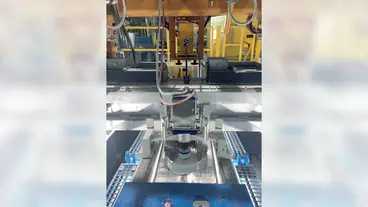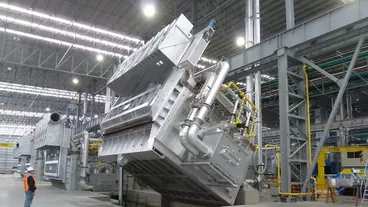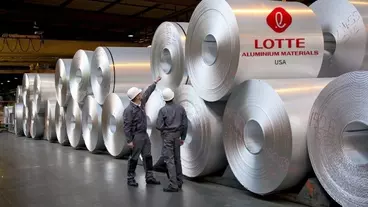Innovative solutions for aluminium casting
Sustainable and efficient casting technologies contribute to meeting the continually increasing requirements for productivity, quality and safety of foundry products.

By J. Valloton, GAP
The choice of casting technology, to the mechanical design of the installation and to choosing suitable process automation (especially concerning quality and product traceability) optimize aluminium production. Process support during commissioning, as well as possible later support in recipe development and optimization, are other important factors, which contribute to an optimal technology transfer. This applies to new installations as well as to retrofitting existing plants.
The activities of GAP Engineering concern mainly the execution of global automation and mechanical solutions for installing new plants as well as for modernizing existing plants.
The competence in the area of aluminium is mainly concentrated on: casting machines, extrusion lines, milling centres for thick plates, sawing centres, thermal processes (quenching, heat treatment) and induction furnaces.
The technological know-how of the various casting processes is important in realizing the projects. To consolidate this know-how, GAP’ Engineering has contractually engaged several process engineers with many years of professional experience in these processes. The task of these process experts is also to familiarize the employees of GAP Engineering with these different technologies and to train the customers’ employees when commissioning the equipment.
To bring innovation to this sector, GAP’s ambition is also to complement current offer by adding new technologies, and thereby to increase safety and traceability in the process for constant quality improvement. We are developing an application, ‘Hawkeye’ software [2], that gives eyes to the operators, by using cameras and images, to monitor the ingot during the casting process. This gives the operators insights about the process by using the power of Computer Vision (CV), Machine Learning (ML), and Artificial Intelligence (AI).
On the business side, this development intends to bring novelty to the industry, by proposing a new product to the customers. In the first stage, our solution tracks the dynamic evolution of the butt curl in real-time, eliminating the need for costly and invasive sensors. By harnessing the potential of AI to standard cameras and by taking advantage of production data, our innovation predicts the ingot’s future development with precision. Process managers gain unparalleled control, foreseeing potential ingot failures and avoiding wasting time, resources, and energy. With the help of a Digital Twin, the system can be used to finely tune the casting parameters to achieve the desired product quality.

Measuring metal level in ingot moulds
Vertical continuous casting is undeniably a potentially high-risk operation – both for the equipment used and particularly for operators. The safety of operators is the first priority and the first measure that should be implemented is to keep operators away from sources of danger. Keeping operators away from the casting machine requires installing highly precise sensors, reactive actuators, and start-up tools there. These tools should enable the process to be managed without the direct involvement of operators, making it part of an automated system, and thereby paving the way to ‘hands-free’ casting.
As explained in the paragraph above, metal level regulation, particularly during the critical start-up phase, is managed using reliable, tried-and-tested components. For many years GAP sensors and actuators have proven to be extremely effective, and their continuous improvement achieves a very high level of reliability.
Mastering metal level in the mould
Using an inductive head, the GLS (Gap Level Sensors) measure the level of metal in the moulds. The sensors allow for continuous monitoring of the metal level changes during all the stages of the casting process. This GAP mastered inductive technology suffers no interference from smoke or metal surface condition, and thanks to the easiness of zeroing it therefore ensures very robust measurement. This sensor also unaffected by grease or smoke deposits, which reduces the need for regular maintenance. The standard period of use can reach up to one year without any need for maintenance. Moreover, the special head design is very tolerant to the proximity of other devices, so allowing a very compact setup as well as reliable, repeatable, and accurate measurements.
Two models are available: the U40 and the U15. The GLS U40 is suitable for casting ingots. The GLS U15 has been developed for casting large rectangular and round billets (diameter > 400 mm). Both sensors have technical support for the next ten years, as they are built with the latest electronic components.
Electromagnetic casting technology (EMC)
One of the most remarkable features of GAP Engineering’s electro-magnetic technology [1] is its ability to improve the microstructure of aluminium, resulting in greater mechanical strength and durability of finished products. What’s more, this innovative technology enables a substantial reduction in surface defects, which in turn improves the aesthetic quality of aluminium products. From the supply of specific equipment, such as ingot moulds, to the commissioning of the installation, our engineers ensure the reliability, efficiency and safety of the production machine. EMC casting is mainly used for alloys that tend strongly to hot cracking (2xxx, 7xxx) or cold cracking (3xxx, 5xxx), and where the products must meet high-quality requirements for surface and internal structure.
The use of EMC for very wide, oval extrusion billets allows a much higher extrusion speed, and hence productivity, thanks to the very thin surface segregation zone. To reach the same productivity, conventionally cast ingots generally need to be scalped (milled) on both flat sides to remove the much thicker segregation zone.

GAPCast
Full automation is essential for the reliable operation of vertical casting. This is why GAP Engineering has developed GAPCast, the Swiss technology that increases security, quality and productivity in aluminium vertical casting. It is a powerful automated casting concept that includes mechanical equipment, electrical supplies, automation software, hardware and commissioning, as well as process support. GAP provides entire turn-key solutions and services for building new, and for modernizing existing, vertical casting machines. GAPCast can be adapted for different casting technologies:
- DC, graphite insert moulds, and EMC tooling sets
- Mould metal level regulation system
- Supply of automation solutions
- Innovative data acquisition coupled with AI technologies
- Supervision and commissioning
- Process support.

Innovation Hawkeye project
As a starting point, the GAP Hawkeye (Hawkeye stands for High Autonomous SoftWare for TracKing ProcEss EfficiencY and SafEty) software [2] intends to propose a live monitoring system for the ingot butt curl. Going from the general to the specific, the objectives are: recognize the butt curl, track the butt curl evolution and analyze the link between the casting parameters and the butt curl
Butt curl tracking
This represents the first step of the project. Mixing Computer Vision (CV) and Machine Learning (ML), this critical step provides the references and information needed to measure the butt curl, references points on the butt must be found and tracked, so as to get a clear view of the butt curl. This is also where the steam and fog factors (and any other perturbation) are handled. Multiple algorithms and processing algorithms are currently under development and testing.
Butt curl analysis
In this step, actual analysis will be performed. Using the data from the previous step, the goal is to measure the butt curl and its evolution. Comparing the actual with the theoretical ideal shape will allow an alarm to be raised if the butt curl is going out of the tolerance.
This analysis will also lay the basis for the next step and so, by annotating the data it will create valuable data links between the casting parameters and the butt curl.
Conclusion
In the ever-changing world of the aluminium industry, innovation continues to play a crucial role in the search for sustainable and efficient solutions. With this in mind, GAP Engineering has introduced a pioneering advance in the aluminium production process. By extending this range of offers, and in particular its technological know-how, the company is now in a position to do technical work on the most diverse casting equipment, from the simplest to the most complicated. Thus the process range includes practically all continuous casting processes that are now available on the market, whether for new plants or for modernizing existing plants. This establishes a firm basis for a very flexible and competent treatment of the most diverse customer requirements.
References
[1] M. Bolliger, B.F. Prillhofer: EMC confirms its quality lead, Increase in capacity at Amag Casting in Ranshofen, International Aluminium Journal, 86 (2010) 7-8, pp. 44-47
[2] M. Fracheboud, M. Rummens, M. Valloton: Revolutionizing Slab Casting: Unveiling the Power of AI and Computer Vision, Light Metals TMS 2024 (to be published).
Author
Julien Valloton, Mechanical Engineer MBA specialized in the metallurgical industry and more particularly in aluminium manufacturing processes. For 15 years now, he has been developing automation, mechanical and process activities for complete aluminium manufacturing lines. He juggles between the different positions of CEO, sales manager and Co-owner of the company GAP Engineering SA. GAP stands for Global Automation Process Engineering Ltd, based in Chalais, Switzerland.

New melting and casting complex in U.S. will use electromagnetic stirrers by ABB and is set to become a beacon for reshoring, recycling and sustainable practices.

Lotte Aluminium Materials and SMS Group have agreed a strategic partnership for logistics and digitalization services.

The ‘KlimPro’ research project investigates the influence on the quality of secondary aluminium of replacing methane fuel in part by hydrogen.
